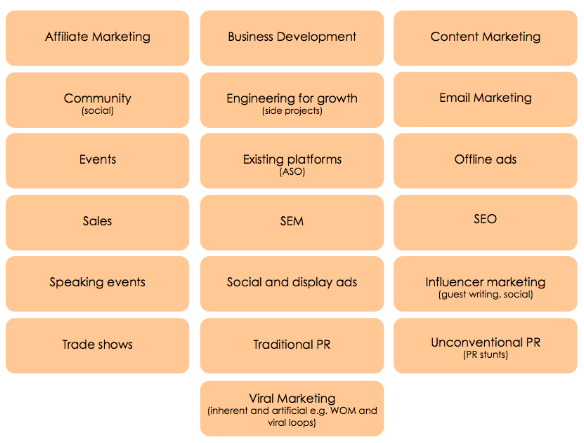How to Find Your User Acquisition Channels
Figuring out which user acquisition channels are going to drive the most growth is key to your business success.
Acquisition channels are diverse and plenty. With many options, how can you create a channel strategy that will really accomplish your goals?
Few companies can afford to actively use more than a handful of channels and, even so, it’s tough to figure out which ones are actually delivering the right customers.
I’ve spent the past few years working with all kinds of businesses across a range of industries to help them figure this out. Instead of sharing a whole list of tactics you can try out yourself, I’m going to share the one consistent strategy I’ve seen add more to the bottom line than any specific channel – trial and error.
It can seem overwhelming at the start, but testing and optimization should become part of your growth DNA. What might seem like a steep learning curve will turn into a path with long-term payoff when you get it right.
Let’s dive in.
Focus on your users, not your channel
There’s so much out there, it’s often hard to know where to start. As a business owner, you might feel a lot of pressure to continue coming up with new ways to connect with and reach your audience.
However, there’s one fundamental thing you need to focus on and continue focusing on from day one. To successfully manage your tests and increase the chances of success, listen to users and understand their perspective. User research is a priority that should, in some way, find a home within the design of any new channel or tactic strategy.
Whether you have 1,000 customers or 100,000, focus on the already successful users and uncover the user acquisition channels that converted these people. Uncover as much as you can about these people to help your growth team understand what triggers and motivates them to take action. What was their user journey with your product or service and how can you repeat it with future customers? Doing this on a regular basis will give you the right lens to narrow the types of tactics and channels that are most likely to drive a positive response from prospective customers.
Set clear goals
If you’re early in your business, finding growth channels is about traction – not scale. With that in mind, before you start experimenting, make sure you’ve set clear goals you’d like to achieve – even if you don’t have much data to base them on.
Whatever user acquisition channels you attempt, testing and refining campaigns will be a critical part of the process. It’s important to measure the ROI of your efforts by channel so that you know which need a bit of tuning and which need a complete makeover or be dropped.
There’s been a lot written about goal-setting! And, you might already know what works best for you. Here are some of our favorite resources if you’d like to learn more about setting intentional goals:
- Buffer: 7 Popular Goal-Setting Strategies That Will Help You Achieve Great Things on Social Media
- Intercom: To perform at your best, focus on goals not tasks
- Databox: The Goal Setting Process We Used to Get to $1M+ in Annual Revenue
- Google Guide: Set Goals With OKRs
Create a ridiculously long list of channels and tactics
Have a million and one things rattling around in your head? Good! Just get it all out there.
A brain dump can help you organize your thoughts and feel more in control, especially when you use it to create a growth list like this one.
Get your team together and build your user acquisition channels list – write it down, type it out, drop it into Google Sheets, whatever you want to do. Don’t worry if it’s unorganized or sporadic, you’ll restructure it later.
Evaluate channel possibility
So you have a big list, now what?
Even lean testing means an entirely new set of processes, resources, and outputs, so it’s important to be intentional with how you and your team spend your time. Attempting to drive growth on too many user acquisition channels at the same time will divide your resources and dilutes your focus.
One way to manage your tests and increase the chances of success is to spend time upfront evaluating emerging channels—the idea is to test and get early access to good opportunities, but you can’t do everything.
Consider the following questions to help you prioritize channels with a “high propensity” to work for your business:
- Does the channel have an audience that roughly matches your customer personas?
- Is this channel crowded or emerging? Are your competitors there and will you have to shell out buckets of cash to play?
- What part of the buyer’s journey do you believe the customer is in when they’re spending time on this platform? How does that align with your business goals?
- Can you effectively filter your ads to reach only your target audience to better manage your costs and get the best bang for your buck?
- Is this a compounding loop? Will this channel enable our users to grow the product for us?
Assemble a team to make it happen
We have seen a lot of founders focus on growth strategies. The starting point for that is almost always, “What should the structure for the growth team be?”
As we’ve outlined in the process above, the first step is defining the user acquisition channels that will or have the biggest impact on growth, and working your way backward to the team needed to execute effectively. When you do that, you will quickly realize that to execute on your ideas you need a cross-functional team with a mix of engineering, product, data, design, marketing, and sales skills. The mix will depend on the particular channel you test.
Which is why I love that we are building Tuff not just for our clients, but also with them. We believe the future of growth agencies is in being value drivers, rather than service providers. Sure, we have a number of top-notch services we regularly execute. But, it’s bigger than that. In order for you to find traction and scale growth for your business, you need a customizable, plug-in growth team.
We’d love to work with you.
Schedule a call with our team and we’ll analyze your marketing, product, metrics, and business. Then, present a Growth Plan with actionable strategies to find and keep more engaged customers.

Ellen is the founder at Tuff and one of the team’s core growth marketers. She is a versatile marketer with expertise in multiple channels – from ppc to seo to email to others – responsible for the experiments and testing. She is happiest when she’s on the ski hill or outside pointing her mountain bike downhill.







